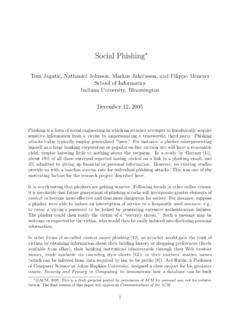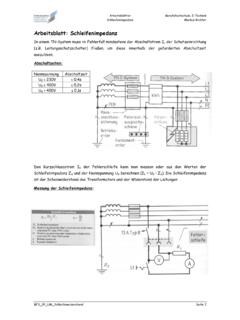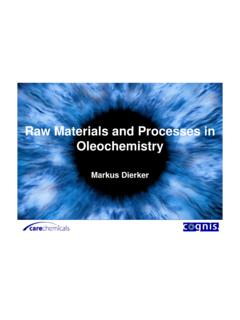Transcription of Canine Hypoadrenocorticism - Addison’s Disease
1 Canine Hypoadrenocorticism - addison 's Disease Markus Rick, Med. Vet. Endocrine Diagnostic Section Diagnostic Center for Population and Animal Health Michigan State University East Lansing, MI 48824, USA. Adrenal Glands Both 1g Yellow cortex, brown medulla Cortex (75%): Z. glomerulosa (25%): mineralocorticoids Z. fasciculata (60%) and Z. reticularis (15%): glucocorticoids, androgens Medulla (25%): Catecholamines More than 30 different hormones Glucocorticoids negative feedback ACTH. Glucocorticoids Glucocorticoids - II. Cortisol Regulates metabolism by increasing gluconeogenesis Increases vascular reactivity Balances water and electrolytes Has anti-inflammatory activity Aldosterone Renin Angiotensin Na , Na , blood blood pressure . pressure at at juxtaglomerular juxtaglomerular apparatus apparatus ACTH- necessary necessary to to maintain maintain baseline baseline Mineralocorticoids.
2 K. K+. Aldosterone - II. Induces renal resorption of Na, Cl, H2O. Releases K through intestines, salivary glands and kidneys Overall it corrects hypotension and changes K against Na and therefore corrects the hyperkalemia and hyponatremia Primary addison 's Disease Gluco- and mineralocorticoid insufficiency is present Primary Disease affects the adrenal gland Common reasons: Idiopathic (atrophy or destruction of adrenal cortices (>85%)), in man 70-90% are immune mediated Autoimmune etiology is not proven in dogs yet, but is suspected Iatrogenic (chemotherapeutical destruction, adrenalectomy). Rare: hemorrhage/ thrombosis, infarction, infiltration In man also: tuberculosis, AIDS. Primary addison 's Disease - II. Normal control adrenal gland, Grade 1. adrenal gland, Grade 3 adrenal gland, No inflammation, cortex collapsed Primary (Adrenal).
3 Renin - Angiotensin ACTH. Mineralocorticoids Na+. Glucocorticoids K+. Secondary addison 's Disease Is not well defined in the literature Glucocorticoid insufficiency only Secondary Disease affects pituitary or hypothalamus, but not the adrenal gland Theoretical reasons: ACTH (or CRH) insufficiency Tumors of pituitary gland or hypothalamus Suppression of ACTH due to drug treatment Secondary (Pituitary Or Hypothalamus). Renin - Angiotensin X ACTH. Mineralocorticoids N. Na+ N. K+ N. Glucocorticoids Exogenous Glucocorticoids Only glucocorticoid insufficiency present Reasons: Potent glucocorticoids cause suppression of ACTH and atrophy of the zona fasciculata and reticularis Others with mineralocorticoid activity might also cause atrophy of the zona glomerulosa as well (not well documented).
4 Exogenous Glucocorticoids Renin - Angiotensin X ACTH. Mineralocorticoids N. Na+ N. K+ N. Glucocorticoids Hypoadrenocorticism Incidence: cases/ 1000 dogs Prevalence (natural): cases/ 1000 dogs Prevalence (natural and iatrogenic): Young to middle aged: 2-7 years (median: 4. years; range 2 months to 14 years). 70% females Castrated males are at higher risk than intact males; females controversial Breed Predisposition Breeds at higher risk include: Bearded Collie Standard Poodle West Highland White Terrier Portuguese Water Dog Leonberger Great Dane Airedale Terrier Basset Hound Wheaten Terrier Rottweiler Who is affected? - II. In these breeds, always consider addison 's Disease as a possibility Consider testing animals with unexplained vomiting, diarrhea or other signs that resolve with fluid and/or glucocorticoid treatment Clinicians at MSU almost test all Portuguese Water Dogs Clinical Findings Clinical signs may be vague and nonspecific and compatible with: Primary GI Disease Primary renal failure Neuromuscular Disease Trichuris vulpis infestation (Whipworms).
5 Sepsis Clinical Findings - II. Most commonly found: Depression, lethargy Weakness Weight loss Anorexia Emesis If acute: Dehydration Diarrhea and vomiting (also chronic). Clinical Findings - III. May be present: Melena Hematemesis Polyuria/ Polydipsia If acute: Bradycardia Weak pulse Slow capillary refill Clincal Findings - IV. Less often reported: Shaking/ tremors Alopecia Megaesophagus (1%), reversible If acute: Hypothermia Painful/ sensitive abdomen Hematology Mild to severe monochromic, normocytic anemia (20-30%). Eosinophilia (20%). Lymphocytosis (10%). Chemistry Hyperkalemia (90%). BUN (86%). Decrease of of sodium:potassium ratio (normal 27-40:1) (90%, recent published: 65%). Hyponatremia (83%). Creatinine (68%). Hypochloremia (46%). Hypercalcemia (30%). Hypoglycemia (20%).
6 Chemistry - II. Don't use a normal Na/K ratio to RULE OUT addison 's Imaging More to rule out other causes: Ultrasound might be useful to define cortical atrophy but requires high skills and good equipment, more helpful in Cushing's Radiographs are less useful, but sometimes you see signs related to hypovolemia/ decreased tissue perfusion including microcardia, narrowed caudal vena cava, descending aorta and hypoperfusion of the lungs Imaging - II. Others Urinalysis: Pre-renal azotemia: well-concentrated urine Renal azotemia: low specific gravity (< ). Helpful to differentiate between renal failure and addison 's Disease Blood pressure Hypotension in approximately 90% (not enough data yet!). Electrocardiogram Changes due to hyperkalemia First: mild changes (tall peaked T-wave).
7 Severe: cardiac arrest Others - II. Endocrinology ACTH response test Most reliable and consistent test available Sample pre- and 1 hour post 250 g/dog (or 5 to 10 g/kg ) cosyntropin (Cortrosyn ). Sample pre- and 2 hours post IU/kg ACTH gel (compounded or Acthar Gel ). Measure cortisol and/or aldosterone Endocrinology - II. Perform ACTH response test prior to glucocorticoid treatment! (Pred and hydrocortisone show cross-reaction in the assay and might cause spurious results). If emergency requires immediate glucocorticoid treatment, use Dexamethasone Endogenous (plasma) ACTH: primary/. secondary in pre-treatment samples Endocrinology - III. ACTH/Cortrosyn ACTH/Cortrosyn Response Response Test Test Primary (adrenal) addison 's Hypoadrenocorticism 600 1000. 500 800.
8 400. 600. 300. 400. 200. 100 200. 0 0. 0 1-2. Endogenous ACTH concentration HIGH; (shaded is cortisol ref ranges). Endocrinology - IV. ACTH/Cortrosyn ACTH/Cortrosyn Response Response Test Test Secondary (pituitary) addison 's Hypoadrenocorticism 600 1000. 500 800. 400. 600. 300. 400. 200. 100 200. 0 0. 0 1-2. Endogenous ACTH concentration LOW ; (shaded is cortisol ref ranges). Endocrinology - V. ACTH/Cortrosyn ACTH/Cortrosyn Response Response Test Test Chronic exogenous glucorticoid therapy 600 1000. 500 800. 400. 600. 300. 400. 200. 100 200. 0 0. 0 1-2. Endogenous ACTH concentration LOW; (shaded is cortisol ref ranges). Endocrinology - VI. Measurement of Aldosterone is a helpful tool to confirm addison 's in a dog pre- treated with steroids A single dose of dexamethasone does effect plasma cortisol baseline ( ).
9 Post-ACTH plasma cortisol concentrations are suppressed on days 1 to 3 after administration of 5mg/kg (33% compared with the control dogs). Endocrinology - VII. Prolonged and excessive use of topical, parental or oral steroids may result in adrenal suppression Another remark: Crossreaction between cortisol and other corticosteroids (apart from dexamethasone) can result in spurious cortisol measurements Acute Obtain diagnostic samples Restore intravascular volume Provide glucocorticoids Check correction of Na/K ratio Treat life threatening cardiac arrhythmias Acute - II. Intravenous fluids Normal saline ( ). 20 - 40 ml/kg/hr for first 1- 2 hours (40 - 80 ml/kg/hr if very severe). Maintenance dose 2 - 3 ml/kg/hr thereafter Glucose solution as necessary Bicarbonate ONLY if blood pH is lower than Goal: reduction of serum potassium concentration, restoration of renal perfusion, correction of acidosis Acute - III.
10 Glucocorticoids Hydrocortisone 5-10mg/kg every 6hrs or (up to 50mg/kg). Glucocorticoid and mineralocorticoid activity Short acting Methyl prednisolone sodium 1 - 2 mg/kg Glucocorticoid and weak mineralocorticoid activity Intermediate acting Acute - IV. If unable to perform diagnostic cortisol test, use dexamethasone in meantime Dexamethasone - mg/kg Dexamethasone SP - mg/kg Very high glucocorticoid activity (8 times more potent than Pred). No mineralocorticoid activity Long acting As animal is stable, gradually reduce dose over next 3-5 days Chronic Mineralocorticoids Desoxycorticosterone pivalate (Percorten V ). mg/kg every 25 days ( . ). No glucocorticoid activity Reassess after 12 days: Na low and/or K high: increase by 10%. Reassess after 25 days: Na low and/or K high: decrease by 5%.








